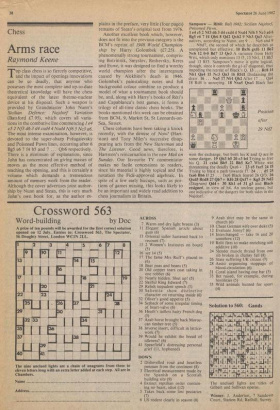Chess
Arms race
Raymond Keene
Top class chess is so fiercely competitive, and the impact of openings innovations can be so deadly, that anyone who possesses the most complete and up-to-date theoretical knowledge will have the chess equivalent of the latest thermo-nuclear device at his disposal. Such a weapon is provided by Grandmaster John Nunn's Sicilian Defence: Najdorf Variation (Batsford £7.95), which covers all varia- tions in the combative line commencing 1 e4 e 2 Nf3 d6 3 d4 cxd4 4 Nxd4 Nf6 5 Nc3 a6. The most intense examination, however, is devoted to the super-sharp Polugaievsky and Poisoned Pawn lines, occurring after 6 Bg5 e6 7 f4 b5 and 7 ... Qb6 respectively. There is a minimum of explanation, since John has concentrated on giving masses of moves as the most effective method of teaching the opening, and this is certainly a volume which demands a tremendous amount of memory work from the reader. Although the cover advertises joint author- ship by Nunn and Stean, this is very much John's own book for, as the author ex-
plains in the preface, very little (four pages) remains of Stean's original text from 1976.
Another excellent book which, however, does not fit into the previous category is the BCM's reprint of 1948 World Champion- ship by Harry Golombek (£7.25). A phenomenally strong tournament, compris- ing Botvinnik, Smyslov, Reshevsky, Keres and Euwe, it was designed to find a worthy world champion after the interregnum caused by Alekliine's death in 1946. Golombek's painstaking notes and full background colour combine to produce a model of what a tournament book should be, and, along with Harry's books of Reti's and Capablanca's best games, it forms a trilogy of all-time classic chess books. The books mentioned this week can be obtained from BCM, 9, Market St, St Leonards-on- Sea, Sussex.
Chess columns have been taking a knock recently, with the demise of Now! (Hart- -ston) and Tony Miles's successive disap- pearing acts from the New Statesman and The Listener. Good news, therefore, is Hartston's reincarnation in the new Mail on Sunday. Our favourite TV commentator makes no facile concessions to readers, since his material is highly topical and the notation the Fide-approved algebraic. In spite of a few early hiccups, such as por- tions of games missing, this looks likely to be an important and widely read addition to chess journalism in Britain. Sampouw — Ribli: Bali 1982; Sicilian Najdorf, Poisoned Pawn.
1 e4 c5 2 Nf3 d6 3 d4 cxd4 4 Nxd4 N16 5 Nc3 a6 6 Bg5 e6 7 14 Qb6 8 Qd2 Qvb2 9 Nb3 Qa3 Alter- natives, according to Nunn, are 9 ... Nc6 and 9 Nbd7, the second of which he describes as unexplored but effective. 10 Bx16 gxf6 11 Be2
m
Nc6 12 0-0 Bd7 13 Qe3 A variance from Holy Writ, which only mentions 13 f5, 13 Nbl, 13 Bh5
s move i
and 13 Rf3. Sampouw's quite logical, though, since it controls the gl-a7 diagonal, thus impeding the retreat of Black's Q. 13 ... Rc8 14 Nbl Qa4 15 Nc3 Qa3 16 Rfdl Disdaining the draw. 16 ... Na5 17 Nbl Qb2 After 17 ... Qa4 18 Rd4 is annoying. 18 Nxa5 Qxal Black has Position after 29 Nd2 won the exchange, but both his K and Q are in some danger. 19 0b3 b5 20 c3 b4 Trying to free his Q. 21 cxb4 Bh5 22 Bh5 Ke7 White was threatening the deadly Qxe6 -I-. 23 e5 fxe5 24 15 Trying to blast a path towards 17: 24 . d5 25 fxe6 Bh6 If 25 ... fxe6 Black feared 26 Qf3. 26 Qxd5 Rcd8 27 Qb7 + Kf6 28 Qx17 + Kg5 29 Nd2 (Diagram) Qd4 + 30 Khl e4 31 g3 and Black resigned, in view of h4. An unclear game, but one indicative of the dangers for both sides in the Najdorf.






















































 Previous page
Previous page